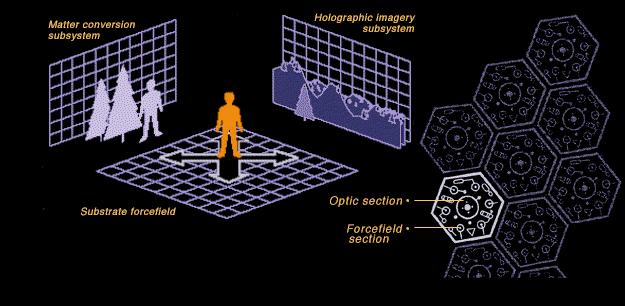The
major stumbling block to Virtual Reality as it existed at this time was
physical - no matter how
good
the computer because at projecting images, sounds, and suchlike to the
user, he or she was
not
actually in a real environment. Although body suits capable of simulating
tactile impressions
had
come into use again by 2120, these where never considered a serious substitute
for actually
handling
real physical objects.
What was needed was a way to physically recreate an environment which the user could then interact with freely. This did not become possible until the invention of the replicator unit in 2315; based on transporter technology, the replicator allowed actual objects to be created in an instant and deleted as needed.
The
first "holochambers" energed in 2328; they used a small room equipped with
a set of holographic projectors which could generate a realistic image
of an outdoors scene onto the walls and ceiling.
A
replicator would then materialise objects within the room to go with the
image - plants and trees, for example. The users where then free to pick
up and use the objects without having to wear any kind of projection equipment
themselves.
Early
holochambers suffered from several limitations; a careless user could easily
walk into a wall,
for
example, and if several users where in one chamber then they could only
be as far away from
each
other as the size of the chamber allowed. The major limitation was in the
creation of characters within the holochamber; although reasonably realistic
images of people and animals could be projected, users could not physically
touch these characters in any way.
More
recent models have largely overcome these problems; a modern holochamber
projects a forcefield across the floor of the chamber, and should a user
walk towards the wall this field begins to act as
a
'treadmill' to keep the person stationary; the computer automatically moves
the replicated objects within the holochamber and adjusts the holographic
projections to simulate the movement the user should experience. Replicated
objects reaching the wall are dematerialized, while images of objects reaching
the space within the chamber are replicated for real.
The
second hurdle was overcome by 'internal partitioning' of the chamber. Should
two people enter
a
holochamber and walk in directly opposite directions, they would previously
only be able to go so
far
before reaching the walls. While the 'treadmill' effect can convince a
user that the environment
is
passing them, it cannot make the users continue to move further away from
each other and so
the
illusion would be broken.
In
modern holochambers, the computer would sense that this was about to happen
and throw up an internal divide; halfway across the holochamber the computer
would throw up a hologram showing
each
user an image of the other, continuing to move further away - essentially
this process creates two minature holochambers within one. Should the users
head back towards each other the computer would reverse the process, merging
the two into one again. A modern holochamber is capable of sub-dividing
into many separate environments, allowing groups of people to wander around
independantly of each other.
Perhaps the most impressive advance in holochamber technology has been the advent of 'holomatter'. This is solid matter created within the holochamber energy grid and manipulated by highly articulated computer driven tractor beams; although early efforts where crude, modern holochambers can use holomatter to create and animate totally realistic characters within the chamber.
The
basic mechanism behind the holochamber is the omni-directional holo-diode
(OHD). The OHD
is
a small unit (several hundred million per square metre in modern holochambers)
which is capable
of
projecting both full colour stereoscopic images and three dimensional forcefields.
The OHD's are circuit-printed onto large sheets, which are then subdivided
into tiles of 0.61 square metres. A typical starfleet Holodeck wall consists
of twelve subprocessing layers totalling 3.5 mm thickness, diffusion bonded
to a lightweight cooling tile. The panel is controlled by an optical data
network similar to that used for standard panel displays. Dedicated subsections
of the main computer system drive the holodeck, and it is the memory and
speed of these computers which determines the number and complexity of
the holodeck programmes available.
Although
modern holochambers are often touted as being just as good as the real
thing, in practice there are still limitations. Even the best holochamber
can only subdivide into a maximum of twelve separate environments, and
many holochamber programmes are not complex enough to make full use of
the holochambers technical capabilities. Perhaps the biggest limitation
is in the holomatter itself; this is only stable within the energy grid,
and looses cohesion almost instantly if removed from the holochamber.
Holochambers
come in various sizes and types; the federation is reputed to have the
best models,
with
Earth boasting some of the largest known holochambers. Starfleet 'Holodecks'
are probably the most technically sophisticated, while the Ferengi are
known for having some of the most advanced and creative entertainment software.

